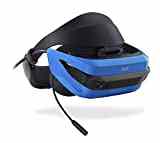Virtual-reality tech is expensive. After all, Microsoft’s own mixed-reality headset, the HoloLens , is yours for just over £3,000. Sure, VR has started getting cheaper, but Acer says those days of parting with oodles of cash to enjoy a proper VR experience are well and truly a thing of the past, with the launch of its own Windows Mixed Reality headset.
But what is mixed reality ? Well, it’s a term that’s hardly well defined. Acer says it’s the process of interacting with virtual objects as if they were physical, although this isn’t exactly a clear-cut definition. The differences between mixed reality and virtual reality? Well, I’d suggest there aren’t any, but more on that later.




Acer Windows Mixed Reality Headset review: What you need to know
Acer’s first stab at a VR headset is an interesting one. It was demonstrated for the first time way back in early 2017 at Acer’s annual press showcase in New York, and it undercuts most serious VR headsets by a considerable margin. It’s supported by Windows, too, as part of Microsoft’s Mixed Reality family of devices and software.
Acer Windows Mixed Reality Headset review: Price and competition
The Acer Windows Mixed Reality Headset (yep, that’s the full, yawn-inducing title), with a bundled set of Oculus-style motion controllers, will set you back a penny under £400.
Acer’s competition? That will be all the other firms signed up for Microsoft’s mixed reality Windows 10 bandwagon. There are five in total: Dell, Acer, Lenovo, HP and Asus. While news on the last two has been a little thin on the ground and Dell’s Visor is now out in the wild , Acer’s headset was the first to launch.
It also faces competition from the strong, already-well-established brands in the VR market. There’s HTC’s Vive , which will set you back £600 ; the Oculus Rift , which is £400 ; and the PlayStation VR at £349 . There are also Samsung and Google’s dirt-cheap mobile-friendly VR headsets to consider: the Gear VR and Daydream View .
Acer Windows Mixed Reality Headset review: Design
Acer’s headset is lightweight and snaps nicely around my bulbous noggin quite nicely. It wasn’t noticeably uncomfortable over my glasses, either, thanks to its roomy interior, something Oculus could learn a thing or two from. Build quality feels a little cheap, though, certainly in comparison to the HTC Vive and Oculus Rift.
But it’s comfortable and practical, and the controllers are decent, too. They look just like Oculus’ touch controllers, with a thumb joystick on the top, sitting to the left of a circular touchpad and the trigger buttons underneath, where your index and middle fingers sit. It’s a design that’s proven and works well.
Acer Windows Mixed Reality Headset review: What does it do?
As far as I could tell, Acer’s headset doesn’t do much different to its Windows 10 rivals. You can pretend you’re in a remote location (Machu Picchu looks lovely this time of year) and view 360-degree footage you’ve taken on your recent skiing trip. You can also do other, more mundane stuff, such as browsing the internet and looking through your emails, all by walking around inside the Microsoft mixed-reality “Cliff House”.
This all works just like that scene with Tom Cruise in Minority Report. The multitasking is easy enough to get to grips with: you plonk multiple windows around your virtual house, dragging and dropping them as you see fit, and teleport to locations using the Oculus Rift-style controllers.
The best thing, though? You don’t need to place extra sensors around the room for it to work. It works entirely through a combination of four specific in-built sensors – a gyro-sensor, accelerometer, magnetometer and proximity sensor – and I never once had any issues with tracking.
You can use it with other Windows-branded VR headsets, too, although I wasn’t able to fully test this out. As all of them use Windows 10 as a base operating system, you should be able to Skype or play VR games with your friends, regardless of which Windows mixed-reality device they own.
However, Acer’s Mixed Reality headset is sorely lacking when it comes to the fun stuff. And no, it’s not Acer’s fault, but the Windows Store’s library of VR-capable games is scarce, and the big-hitters – such as Arizona Sunshine and SUPERHOT VR – are already sitting on competitor’s platforms.
And that’s a real shame. The Oculus Store is overflowing with hundreds of excellent titles, and it’s clear Microsoft hasn’t given its games offering any proper love. If Microsoft wants to market these devices to the average consumer, it desperately needs to put in some more effort here. Yes, Steam VR support is coming soon – that should widen your games choices – but as it stands these headsets are little more than wasted potential.
Acer Windows Mixed Reality Headset review: Performance and specifications
Acer’s MR headset is equipped with a 2.9 x 2in LCD display, providing a resolution of 1,440 x 1,440 for each eye with a maximum refresh rate of 90Hz. This drops to 60Hz on a machine equipped with integrated graphics.
And the good news is that the minimum specification requirements suggest a VR headset that is anything but power-hungry. To achieve solid, reliable frame rates, Acer recommends a machine with at least 8GB of DDR3 memory, an integrated Intel HD Graphics 620 chip or Nvidia GeForce GTX 960M, and an Intel Core i5-7200U processor. That’s nowhere near as demanding as the Vive or Rift.
Plugging the headset into an Acer Spin 7, with an Intel Core i7-7Y75 processor and 8GB of RAM with no dedicated graphics chip, this MR headset ran like a dream. Movement was fluid at what seemed like a stable 60fps, and I only had the headset crash on me once during my time with it.
It’s also less connection-heavy than your typical VR headset. Simply plug in the pair of USB 3 cables and the solitary HDMI cable, snap the batteries into the motion controllers and you’re all set. No faff, and you’re up and ready in a matter of minutes.
Acer Windows Mixed Reality Headset review: Verdict
Acer’s Windows Mixed Reality headset may be a mouthful, but it’s certainly a decent first effort. I might be jumping the gun a little – other devices in Microsoft’s mixed-reality umbrella haven’t reached my desk just yet – but I’m completely sold on this interconnected approach to virtual reality.
The headsets are dirt-cheap, and hardware requirements are low, but the caveat is that there’s nothing useful you can do with them just yet. I’m yet to be wowed by any software, and Microsoft’s games library is sorely lacking in exclusive titles.
And sure, it may not be as technically impressive as Microsoft’s own HoloLens headset, and it doesn’t completely map out your living room, but at just over 10% of the cost, these complaints can be shrugged off.
It may still be in its infancy, but I can safely see Acer’s VR headset (along with those other Windows-labelled devices) paving the way for the future of virtual reality. With costs kept down low, Acer’s Mixed Reality headset has all the hallmarks of a best-seller.






Leave a Reply